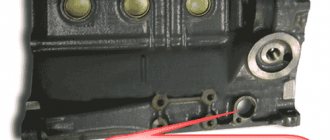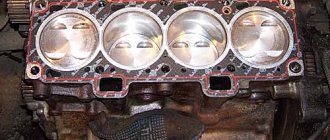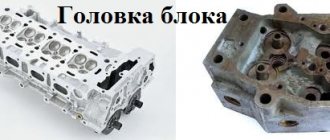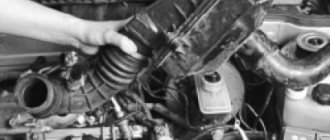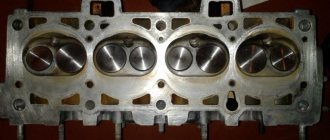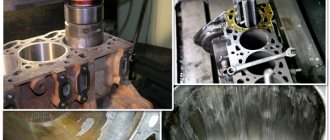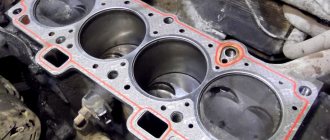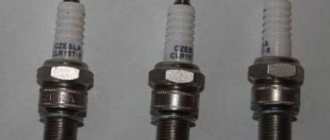Differences between VAZ cylinder blocks
In terms of external elements and design, the 2103 cylinder block
differs little from the VAZ 2106 block. The main distinguishing parameter is the diameter of the cylinders. For VAZ 2103 it is 76mm. and for VAZ 2106 -79mm.
On the right side, on the surface of the “03” block, there is a cast inscription – “2103” and, accordingly, “2106” - for “06”. On the left side, near the upper plane of the BC, opposite the 3rd cylinder, the inscriptions “03” or “06” are cast.
Since 2005, a surge has appeared on the blocks, in the area of the 3rd cylinder. However, on production engines with cylinder blocks 2103 and 2106, this boss was never used to accommodate either a knock sensor or other attachments.
For better recognition, the blocks are painted in different colors. Bl. cylinder 2103 is painted gray and the cylinder block is 2106
- in blue color.
When assembling the engine, the cylinder blocks of the VAZ 2103 and VAZ 2106 are equipped with a drive cover 2101-1002060-01. On “classic” injection engines, a drive cover is installed - 21214-1002060.
Cylinder block 21213
is already more different from the “03rd” and “06th” blocks. A special feature of the VAZ 21213 BC was the increased cylinder diameter - 82 mm. This diameter still allows the cooling jacket cavities to be preserved between adjacent cylinders. Subsequently, several other models were developed based on this block. After the unification of the casting shape, we can talk more about modifications of the 21213 cylinder block than about the original products - blocks 21214, 2123 or 2130.
On the bl. cylinder 21213 there are no holes for mounting additional attachments and sensors used on injection engines.
On the right side of the body there is a cast inscription - “21213”. On the same side, a tide appeared between the second and third cylinders. On block 21213, there is no threaded hole on the tide. There may be an option when there is a hole, but the thread is not cut. On other models with an injection version of the engine, this tide has a hole with an M8 thread for the knock sensor.
On the left side, on the body, in . Near the oil filter installation location, below the fuel pump installation location, there are two untreated bosses. The tide in the upper part of the casting, opposite the third cylinder, became higher than on the “03” or “06” blocks.
On a carburetor engine, together with block 21213, front cover 2101 is used. The product is painted gray.
For BC 2130, the same casting is used as for model 21213. A feature of the cylinder block 2130 is the increased height of the housing. (see Cylinder block dimensions). For external differences, cylinder block 2130
, in the area of the breather is marked with paint.
There are no other differences between blocks 21213 and 2130.
At the moment, several modifications of the VAZ 21214 engine are mass-produced. All of them are injection engines and all of these engines use the VAZ 21214 cylinder block
. Cylinder block 21214 is the same recognizable “21213th” block. On the surface of the case, on the right side, the inscription “21213” is cast. The casting contains all the bosses that are also present on the VAZ 21213 model. A feature of the VAZ 21214 block is the presence of holes on these bosses. First of all, these are threaded holes for the knock sensor, power steering pump bracket and ignition module bracket. There is one more difference between cylinder blocks 21214, 2123, 21213. This difference is related to product markings. (see Cylinder block design). The block is painted gray.
The oil pump drive gear lock is installed in place of the ignition distributor. Together with the cylinder block 21214, a drive cover - 21214-1002060 - is installed on the engine. The cover has a bracket for installing the crankshaft position sensor.
The hole for the fuel pump is closed with a special plug 21214-1002043.
A feature of the VAZ 2123 cylinder block can be considered the presence of additional threaded holes for attaching the oil filter bracket (2123-1012028). The rest of the cylinder block is 2123
no different from “21214”. The product is painted gray.
All modifications of the VAZ 2123 engine are equipped with a drive cover - 2123-1002060-10. The lid is similar to the mod. 21214, but has three studs for fastening the drive elements of auxiliary units. In addition, the sensor mounting bracket is made higher; this displacement of the sensor position along the axis of the crankshaft is necessary due to the use of a wider V-ribbed belt on the engine.
The original engine mount brackets are installed on the 2123 cylinder block.
Source: www.motors-vaz.ru
What does the VAZ engine block marking mean?
In terms of external elements and design, the 2103 cylinder block
differs little from the VAZ 2106 block. The main distinguishing parameter is the diameter of the cylinders. For VAZ 2103 it is 76mm. and for VAZ 2106 -79mm.
On the right side, on the surface of the “03” block, there is a cast inscription - “2103” and, accordingly, “2106” - for “06”. On the left side, near the upper plane of the BC, opposite the 3rd cylinder, the inscriptions “03” or “06” are cast.
Since 2005, a surge has appeared on the blocks, in the area of the 3rd cylinder. However, on production engines with cylinder blocks 2103 and 2106, this boss was never used to accommodate either a knock sensor or other attachments.
For better recognition, the blocks are painted in different colors. Bl. cylinder 2103 is painted gray and the cylinder block is 2106
- in blue color.
When assembling the engine, the cylinder blocks of the VAZ 2103 and VAZ 2106 are equipped with a drive cover 2101-1002060-01. On “classic” injection engines, a drive cover is installed - 21214-1002060.
Cylinder block 21213
is already more different from the “03rd” and “06th” blocks. A special feature of the VAZ 21213 BC was the increased cylinder diameter - 82 mm. This diameter still allows the cooling jacket cavities to be preserved between adjacent cylinders. Subsequently, several other models were developed based on this block. After the unification of the casting shape, we can talk more about modifications of the cylinder block 21213 than about the original products - blocks 21214, 2123 or 2130.
On the bl. cylinder 21213 there are no holes for mounting additional attachments and sensors used on injection engines.
On the right side of the body there is a cast inscription - “21213”. On the same side, a tide appeared between the second and third cylinders. On block 21213, there is no threaded hole on the tide. There may be an option when there is a hole, but the thread is not cut. On other models with an injection version of the engine, this tide has a hole with an M8 thread for the knock sensor.
On the left side, on the body, in . Near the oil filter installation location, below the fuel pump installation location, there are two untreated bosses. The tide in the upper part of the casting, opposite the third cylinder, became higher than on the “03” or “06” blocks.
On a carburetor engine, together with block 21213, front cover 2101 is used. The product is painted gray.
For BC 2130, the same casting is used as for model 21213. A feature of the cylinder block 2130 is the increased height of the housing. (see Cylinder block dimensions). For external differences, cylinder block 2130
, in the area of the breather is marked with paint.
There are no other differences between blocks 21213 and 2130.
At the moment, several modifications of the VAZ 21214 engine are mass-produced. All of them are injection engines and all of these engines use the VAZ 21214 cylinder block
. Cylinder block 21214 is the same recognizable “21213th” block. On the surface of the case, on the right side, the inscription “21213” is cast. The casting contains all the bosses that are also present on the VAZ 21213 model. A feature of the VAZ 21214 block is the presence of holes on these bosses. First of all, these are threaded holes for the knock sensor, power steering pump bracket and ignition module bracket. There is one more difference between cylinder blocks 21214, 2123, 21213. This difference is related to product markings. (see Cylinder block design). The block is painted gray.
Differences between VAZ cylinder blocks
The 21083 cylinder block was originally designed for the parameters of a carburetor engine. Consequently, it did not provide for the presence of areas for fastening elements by analogy with injection engines, including the ignition module, knock sensor, etc. Subsequently, the casting of the model is unified, as a result of which it becomes uniform for blocks 21083, 2110 and 2112. They all have the same height and can be used on engines with a volume of 1500 cm3. Therefore, the body of these blocks is cast. Today, a product with item number 21083-100201100 is shipped from factories as a spare part.
The body of the “83rd” has tides, the same as on all other engine blocks of front-wheel drive VAZ cars. However, there are threaded holes here only on the bosses involved in installing the equipment. The unified cylinder block for the VAZ 21083 also has a boss for installing an oil level sensor, which is located under the oil filter. In order to secure the block head on the upper plane there are 10 holes in the M12x1.25 format. The color of the cylinder block 21083 is blue.
The unification of “083” led to the loss of the VAZ 2110 cylinder block of its characteristic features associated with additional tides on the body. Outwardly, today it is indistinguishable from “083”. The BC 2110 also uses three upper threaded holes and three lower holes of the casting part for installing the right engine support brackets and mounting the generator mounting plate. Since this product is mounted on “injection” engines, the cylinder block has space for installing a knock sensor.
By analogy with “083”, it is assumed that an oil level sensor will be installed here. In addition, the 2110 cylinder block is often used to assemble VAZ 21083 engines. The color of the 2110 block is gray.
Cylinder block 2112 is externally indistinguishable from blocks 2110 and 21083, but it is interchangeable with them. Its main feature is the presence of mounting holes for the block head, size M10x1.25. In addition, additional oil channels with special oil nozzles pressed into them are mounted in the second, third, fourth and fifth main bearing supports. It is through them that when the engine is running, oil under pressure can wash the piston bottoms. As a result, their thermal deformation is reduced and lubrication is improved, which is especially important when starting the engine. The resource of the latter is thus significantly increased. The color of cylinders 2112 is grey.
The 21114 cylinder block is actually a modernized model 2110. During the changes, the engine capacity was increased to 1.6 liters. That is why the block became “high” - 197.1 mm. Otherwise, the BC 21114 is practically no different from the 2110. The main feature of this unit is the absence of a boss and a mounting hole for the oil level sensor under the filter. The block head is attached to holes with M12x1.25 threads. There are no oil jets for cooling the pistons on the side. Block color 21114 is blue.
Today AVTOVAZ does not produce cylinder block 21114; the alternative model is BC 11183. These two models are virtually identical. The color of the cylinder block 11183 is grey.
Cylinder block 11193 is intended for installation on the VAZ 21124 engine. It is a modified and modernized block 2112. However, model 11193 is taller - 197.1 mm, due to which the engine capacity is increased to 1.6 liters.
The difference between VAZ engine blocks
The 21083 cylinder block was originally designed for the parameters of a carburetor engine. Consequently, it did not provide for the presence of areas for fastening elements by analogy with injection engines, including the ignition module, knock sensor, etc. Subsequently, the casting of the model is unified, as a result of which it becomes uniform for blocks 21083, 2110 and 2112. They all have the same height and can be used on engines with a volume of 1500 cm3. Therefore, the body of these blocks is cast. Today, a product with item number 21083-100201100 is shipped from factories as a spare part.
Vazovsky “one and seven”
VAZOVSKY “ONE AND SEVEN”
VAZOVSKY “ONE AND SEVEN”
There is an opinion among motorists that the new 1.7-liter Niva engine is just a “bored” VAZ 2121 engine with a displacement of 1.6 liters. In fact, 21213 is essentially a new unit. The head of the research and development department of East German VAZ engines talks about it
The new engine was conceived as the most powerful for the then prestigious “Seven” - accordingly, its index in the design documentation was 21073.
In its current form, the engine never made it to rear-wheel drive models, but it turned out to be very useful for the modernized Niva, significantly increasing its power capacity or, more simply, adding agility. The increased torque (see Table 1) and its other characteristics made it possible to reduce the gear ratios of the main pairs from 4.1 to 3.9 and introduce a fifth, increasing stage in the box. The real result is the best dynamic performance of the modernized Niva: acceleration to 100 km/h in 19.21 seconds (was 23.25) with approximately the same fuel consumption. And, of course, more power allows you to reach a higher maximum speed of 137 km/h (previously 132 km/h). The engine borrowed its new designation from the VAZ 21213.
While we were talking about an engine with a carburetor, there is also an option with central fuel injection. In addition to Nivas, it is installed on classic Lada cars (models 21214, 21074, 21044), and our car enthusiasts are familiar with them only thanks to re-export.
Why didn't they make the Niva with a 1.7-liter engine before? Let's remember what engines were made at VAZ before the “eighth” family. Their “geometry” was strictly specified by the technology and equipment available at the plant: the distance between the centers of the cylinders is 95 mm, the piston stroke is 66 or 80 mm, the diameter of the cylinder (and piston) is 76 and 79 mm. This resulted in four units of different working volumes, of which the largest was 1.6-liter. By the way, at VAZ four different blanks of cylinder blocks are cast, differing in height and diameter of the cylinders, both internal and external. That is, the cylinder wall thickness is the same for the 2103 (76x80), and 2106 (79x80), and others. A very important conclusion: none of the VAZ engines with cylinders with a diameter of 76 mm are designed for boring to 79 mm, which is what amateur repairmen sometimes do. The time has come for a major overhaul - bore the cylinders to your heart's content, but only to a repair diameter increased by 0.4 or 0.8 mm.
A block with 82 mm cylinders and corresponding equipment appeared at VAZ with the development of model 21083 (82x71 mm). The opportunity has opened up to transfer the 82 mm size to classic engines. The ratio of cylinder diameter and piston stroke of 82x80 mm corresponds to a volume of 1690 cm3 (1.7 l) for engine 21213 (Fig. 1). To complete the historical part, we note that this engine absorbed the technical solutions of three families at once - the closest to it was the classic 2101–2106, the diesel engine developed by that time and the “front-wheel drive” 2108–21083.
Engine block 21213 retained the center-to-center distance of 95 mm from the classic ones. The larger cylinder diameter forced the coolant passages between the cylinders to narrow. By the way, any subsequent increase in diameter will lead to the need to create a flow-free unit similar to model 21083.
The crankshaft is original, fully counterbalanced (Fig. 2). On the shafts of the first generation motors there were only four counterweights, on the shafts of the 2108, diesel and 21213 family there were twice as many, on each cheek to reduce vibrations. Actually, this shaft moved from a diesel engine to the “two hundred and thirteenth” - a concrete example of unification.
The beds in the cylinder block and liners are the same for all VAZ engines, but the crankshafts differ in the thickness of the journals. “Two hundred and thirteenth,” like “eighth,” has journals of increased diameter—by about two hundredths compared to shaft 2101 or 2103. Thus, the clearances in the plain bearings have decreased by 0.02 mm and the oil layer between the parts has become thinner , approaching the optimal value of 0.02. 0.05 mm. The benefits of the innovation can be explained as follows: parts move less in a thin oil layer, which means dynamic loads and vibrations are reduced; at the same time, an excessively small gap in the plain bearings is also unacceptable - there must be lubrication somewhere!
The connecting rod is new. Small clearances in the plain bearings made a requirement: the connecting rod cap should not warp at all when the bolts are tightened. Therefore, the bolts are motionless and firmly seated in the body of the connecting rod, and on their rod there are centering bands for the holes in the cover. An important warning - now the bolts cannot be knocked out: during repairs they must remain in the connecting rod.
The upper head of the connecting rod is made for a “floating” piston pin (Fig. 3) - a solution that came from a diesel engine. A steel-bronze bushing is pressed into the head, the internal diameter of which is divided into three classes (every 0.004 mm) - just like the pistons. It is clear that the class of connecting rod, piston and pin must be the same. The connecting rod class is stamped on the top head (not to be confused with the cylinder number stamped below and on the cover, and the weight marking made in paint); the class of the finger is indicated by paint on the end (blue - first, green - second, red - third); The class of the piston based on the pin hole is marked with a number on the bottom.
The piston is original, with part of the combustion chamber in the bottom. This is perhaps the most interesting feature of the new engine. Separated combustion chambers (part in the head, part in the piston, part in the slot, see ZR, 1996, No. have been known for a long time. The whole trick is to find the best shape of the chamber. And it seems that VAZ specialists managed to do this. Main combustion chamber (in the block head) - wedge-shaped, similar to the chambers of other Zhiguli engines. The additional volume of the chamber is a recess in the bottom of the piston (in shape - part of a flattened ellipsoid) and holes for valves). This recess was invented by the motor closers, as evidenced by the received patent.
This is perhaps the most interesting feature of the new engine. Separated combustion chambers (part in the head, part in the piston, part in the slot, see ZR, 1996, No. have been known for a long time. The whole trick is to find the best shape of the chamber. And it seems that VAZ specialists managed to do this. Main combustion chamber (in the block head) - wedge-shaped, similar to the chambers of other Zhiguli engines. The additional volume of the chamber is a recess in the bottom of the piston (in shape - part of a flattened ellipsoid) and holes for valves). This recess was invented by the motor closers, as evidenced by the received patent.
The difference between VAZ engine blocks
Cylinder block 21083
was originally created for a carburetor engine and did not provide for the presence of mounting points for elements found on injection engines (knock sensor, ignition module, etc.). Later, the casting of the model was unified and became the same for models 21083, 2110 and 2112. All these models are distinguished by the fact that they have the same height and are used on engines with a volume of 1500 cm3. Therefore, on the body of all these blocks, there is an inscription in the casting - “21083”. Now a product with the item number – 21083-100201100 – is being shipped from the factory as a spare part.
On the body of the “83rd” tides appeared, which are present on all models of the “front-wheel drive” engine family. But threaded holes are present only on the bosses that are used to install the equipment. On the unified cylinder block of the VAZ 21083, below the installation location of the oil filter, a boss and holes appeared for installing an oil level sensor. For fastening the block head on the upper plane there are ten holes M12x1.25. Cylinder block 21083 is painted blue.
After the unification of the “083rd”, the VAZ 2110 cylinder block
has lost its distinctive features associated with the presence of additional tides on the body. Now it looks no different from “083”. In BC 2110, to install the right engine mount bracket and the generator mounting plate, three threaded holes are used in the upper part and three holes in the lower part of the casting for the generator bracket. The product is installed on “injection” engines, so there is a place on the cylinder block for installing a knock sensor.
As in the “083”, the installation of an oil level sensor is provided. Cylinder block 2110 can be used to assemble a VAZ 21083 engine. Block 2110 is painted gray.
In collaboration with the Federal Mogul company, a new VAZ 21126 engine was created. The main task facing the specialists was to increase the service life of the engine and ensure compliance with increased environmental standards for exhaust toxicity. The VAZ 11193 cylinder block was taken as the basis. The modified product received a new designation - 21126. Cylinder block 21126
distinguished by the quality of surface treatment of the cylinder, made using Federal Mogul technology. Using this technology, the surface of the cylinder is subjected to flat-top honing. This operation ensures that a network of microgrooves of a certain profile is obtained on the surface of the cylinder. The micro-profile allows the lubricant to be retained on the surface of the cylinder, significantly reducing friction losses.
Cylinder block 11194
, was specially designed for the 1.4 liter engine. For this purpose, the cylinder diameter was reduced to 76.5 mm. Externally, structurally and in terms of the presence of places for mounting equipment, the block does not differ from model 11193 or model 21126. However, the cylinder block 11194 has a hidden difference; this feature distinguishes it from other “front-wheel drive” blocks.
Reducing the diameter of the cylinders made it possible to create cooling jacket ducts between adjacent cylinders. This significantly improved heat dissipation and increased structural rigidity. The surface treatment of the cylinders is carried out using Federal Mogul technology, similar to the processing performed on the “21126”. On the surface of the case there is an inscription - “11194”. The VAZ 11194 cylinder block is painted blue.
Source
Cylinder head of VAZ 2107.
Greetings to you, visitors of my website zerga.ru. Continuing the section on the engine, this article will focus on the cylinder head. As it turned out, there is something to tell about her. A lot of confusion sometimes occurs when we are faced with the repair or maintenance of this unit. And to sort out these ambiguities, I decided to write this post.
What will we talk about in this article? I will try to describe in more detail the structure of the cylinder head itself, that is, what is installed, where and how it is screwed. What are the differences between the heads, and what points need to be given special attention.
What models will we talk about? In this post I decided to write about the Classic models VAZ 2101-2107 and VAZ 2108-2199. This information will be useful for other brands of VAZ cars that have an 8-valve head. I will write a separate article about 16 valve heads, no matter what happens all mixed up. Well, I think you will understand me :).
The design of the cylinder head of VAZ 2107 and 2108.
The cylinder head is made of an aluminum alloy containing a certain percentage of copper and tin in order to give it softness and elasticity. With these properties, it is pressed tightly against the gasket, preventing gas breakthrough.
The entire head is attached to the cylinder block with eleven bolts, ten large and one small, which are tightened with a certain sequence and force. Everything is described in more detail in the article (Replacing the VAZ cylinder head gasket), I recommend reading it.
If you look at the cylinder head from the spark plug side, the coolant temperature sensor is neatly located near the spark plug of the fourth cylinder.
This sensor monitors the intensity of heating of the coolant and transmits a signal to a device in the panel. I recommend reading the article (Temperature Sensors) for more details on temperature sensors.
Purpose of the cylinder head
In internal combustion engines, the cylinder head (cylinder head), (often called simply the head) is installed and secured to the cylinder block.
The cylinder head seals the cylinders, creating closed combustion chambers. A cylinder head gasket is installed between the cylinder head and the cylinder blocks. The design of the cylinder head can be different and vary significantly depending on the type of engine. Valves with springs, spark plugs and injectors are mounted in the block head.
Characteristics of the VAZ 2106/2121 Niva engine
| Parameter | Meaning |
| Configuration | L |
| Number of cylinders | 4 |
| Volume, l | 1,570 |
| Cylinder diameter, mm | 79 |
| Piston stroke, mm | 80 |
| Compression ratio | 8,5 |
| Number of valves per cylinder | 2 (1-inlet; 1-outlet) |
| Gas distribution mechanism | SOHC |
| Cylinder operating order | 1-3-4-2 |
| Rated engine power / at engine speed | 54.8 kW-(74.5 hp) / 5400 rpm |
| Maximum torque/at engine speed | 104 N•m / 3400 rpm |
| Supply system | Carburetor |
| Recommended minimum octane number of gasoline | 92 |
| Environmental standards | Euro 0 |
| Weight, kg | 121 |
Purpose of the cylinder head
In internal combustion engines, the cylinder head (cylinder head), (often called simply the head) is installed and secured to the cylinder block.
The cylinder head seals the cylinders, creating closed combustion chambers. A cylinder head gasket is installed between the cylinder head and the cylinder blocks. The design of the cylinder head can be different and vary significantly depending on the type of engine. Valves with springs, spark plugs and injectors are mounted in the block head.
Cylinder block
The cylinder block is its own, marked 2106-1002011, cast from high-strength cast iron, differs from block 2103 only in the increased cylinder diameter.
| Parameter | Meaning |
| Material | Ductile iron |
| Cylinder diameter, mm | 79,0 |
| Intercylinder distance (distance between the axes of adjacent cylinders of the block), mm | 95,0 |
| Block height (distance between the upper plane of the block and the axis of the crankshaft), mm | 215,9 |
| Diameter of boring of crankshaft supports (for main bearings), mm | 54,52 |
| Weight, kg | 39,200 |
Cylinder head malfunctions:
- gas breakthrough, causes: curvature of the gas joint, corrosion, damage to fasteners;
- crack, loss of seat;
- wear of the fit under the camshaft or pushers;
- wear of valve guides;
- broken fasteners, broken spark plug threads or bolts, cracks.
Malfunctions of the cylinder head also include breakdowns or wear of such cylinder head parts as: valves, springs, rockers, compensators.
Broken threads for the spark plug are eliminated by installing a screwdriver; the torn fasteners are replaced with repair studs.
Defects in the cylinder head include cracks. A crack in the cylinder head, as a rule, leads to the breakthrough of gases into the cooling jacket and engine failure (in this case, repairing the cylinder head is not advisable). Most often, a crack in the cylinder block is an indication for replacing the part. Cracks outside the gas joint can be welded.
If excessive knocking noises appear and the oil pressure decreases, this may be due to wear of the camshaft beds. In this case, the beds are restored with bronze bushings.
Damage from corrosion and detonation can also make repairs impossible.
A seat that has fallen out must be replaced.
If you are faced with wear on the cylinder head, you should correctly inspect the head in order to determine whether to repair or buy a cylinder head.
Source: www.autoezda.com
Designation of the cylinder head on a VAZ
The 21083 cylinder block was originally designed for the parameters of a carburetor engine.
Consequently, it did not provide for the presence of areas for fastening elements by analogy with injection engines, including the ignition module, knock sensor, etc. Subsequently, the casting of the model is unified, as a result of which it becomes uniform for blocks 21083, 2110 and 2112. They all have the same height and can be used on engines with a volume of 1500 cm3. Therefore, the body of these blocks is cast. Today, a product with item number 21083-100201100 is shipped from factories as a spare part. The body of the “83rd” has tides, the same as on all other engine blocks of front-wheel drive VAZ cars. However, there are threaded holes here only on the bosses involved in installing the equipment. The unified cylinder block for the VAZ 21083 also has a boss for installing an oil level sensor, which is located under the oil filter. In order to secure the block head on the upper plane there are 10 holes in the M12x1.25 format. The color of the cylinder block 21083 is blue. The unification of “083” led to the loss of the VAZ 2110 cylinder block of its characteristic features associated with additional tides on the body. Outwardly, today it is indistinguishable from “083”. The BC 2110 also uses three upper threaded holes and three lower holes of the casting part for installing the right engine support brackets and mounting the generator mounting plate. Since this product is mounted on “injection” engines, the cylinder block has space for installing a knock sensor.
By analogy with “083”, it is assumed that an oil level sensor will be installed here. In addition, the 2110 cylinder block is often used to assemble VAZ 21083 engines. The color of the 2110 block is gray.
Today AVTOVAZ does not produce cylinder block 21114; the alternative model is BC 11183. These two models are virtually identical. The color of the cylinder block 11183 is grey.
The 21126 cylinder block has the highest quality surface treatment, performed in accordance with Federal Mogul technology. During this process, the cylinder is subjected to flat-top honing, which makes it possible to obtain a network of microgrooves of a special profile on its surface. It is this that reliably holds the lubricant on the surface of the product, while reducing energy loss due to friction. Thus, the honing technology that is used at AVTOVAZ when processing the surface of the cylinders of the VAZ 21126 block differs from previous models.
Federal Mogul has developed the main technological parameters for surface honing. This includes the angle of inclination, its profile, and the frequency of application of microgrooves. When performing the operation, high-quality equipment from Federal Mogul is used. High manufacturing precision makes it possible to determine three groups of cylinder sizes: A, B, C. The reliability of the engine is increased not only due to the new manufacturing technology of the cylinder block, but also due to the new piston kit, which consists of a piston + pin + rings + connecting rod. The color of the cylinder block 21126 is blue.
Cylinder block 11194 is a specialized development for engines with a volume of 1.4 liters. In this regard, the cylinder diameter was reduced to 76.5 mm. However, in terms of its design and the presence of places for mounting equipment, block 11194 is practically indistinguishable from models 11193 and 21126. However, cooling jacket ducts are made between adjacent cylinders, due to a decrease in their diameter. This made it possible to improve heat dissipation and increase structural rigidity. A similar treatment of the surface of the cylinders in accordance with Federal Mogul technology is carried out on model 21126. The color of the VAZ 11194 cylinder block is blue.
Source
